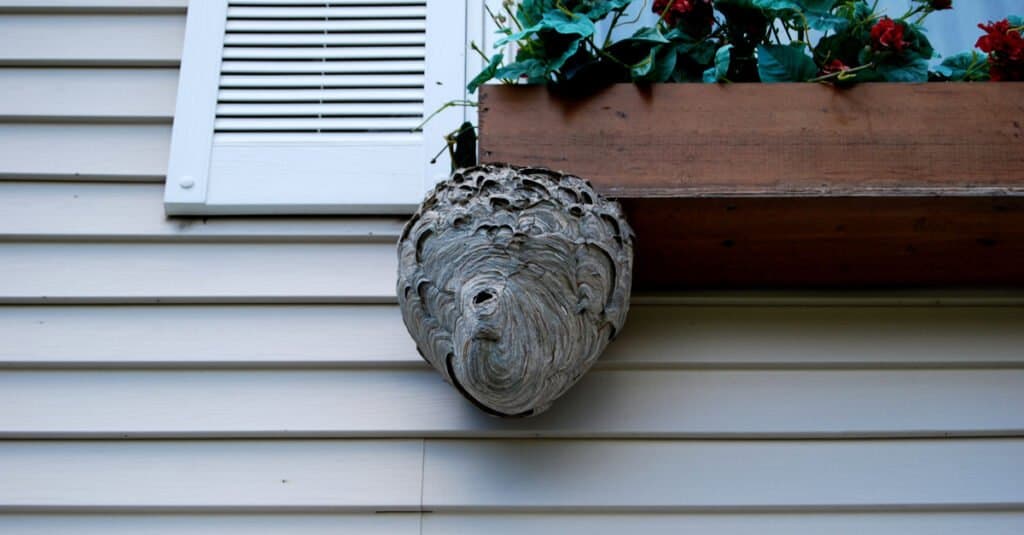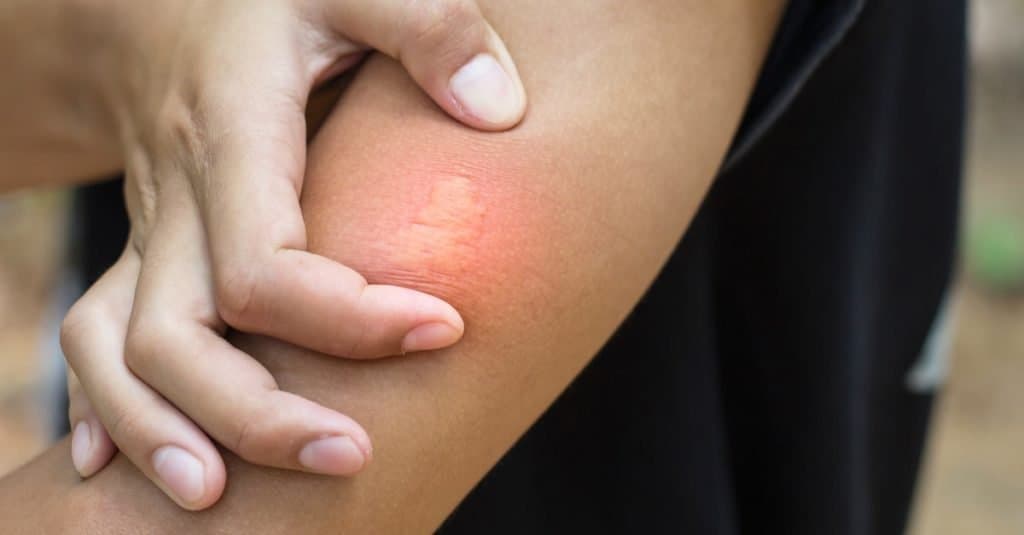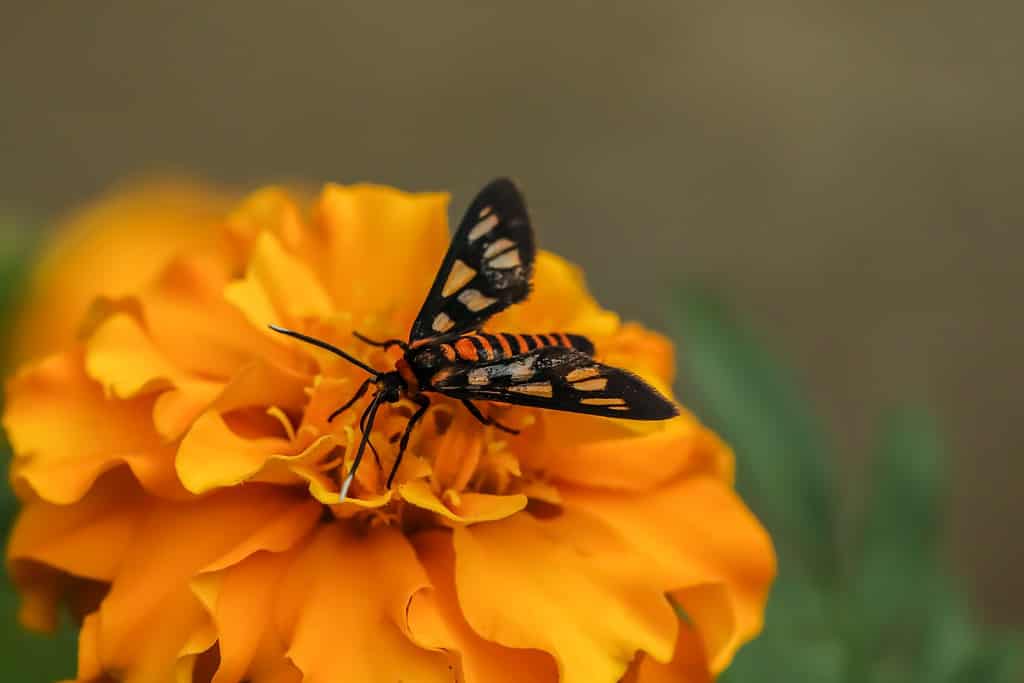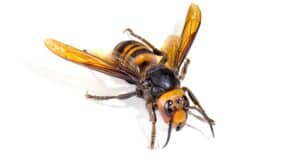Was that large, buzzing insect a wasp or a hornet? What do they look like? Should you be afraid of it or try to kill it? Who would win in a fight between hornets and wasps?
Find out by reading more below:
Hornets vs Wasps

Hornet nests are normally built above ground. If endangered, the entire swarm can attack an intruder.
©Klod/Shutterstock.com
Comparing hornets vs wasps is a bit of a misnomer, as hornets are actually a specific type of wasp. But it’s easy to tell hornets from common wasps.
First, consider the similarities. Both species are flying, stinging insects. As true insects, they have six legs. Both types can sting more than once, as they don’t leave their stingers behind as honeybees do. But only the females can sting. Both are carnivores, feeding on other insects.
The significant difference between wasps and hornets is size and color. Wasps are about one-third inch (one centimeter) to one inch (two and one-half centimeters) long. Hornets are larger. Wasps have black and yellow rings, while hornets have black and white rings.
Hornets vs wasps in appearance, wasps are generally slender, while hornets are rounder and “fatter.” Hornets are usually yellow and black striped like a stereotypical bee, while wasps may be striped or solid red, black, or even blue.
Nest types vary for both species. Hornets vs wasps may each build “paper” nests of bits of chewed wood fibers and saliva. When comparing the size of the nests, a typical hornet nest can get up to the size of a basketball or larger and is found in tree branches, eaves, and shrubs. Their colony size can range from 100-700 workers plus a queen.
A wasp nest has a hexagonal shape that measures 6-8 inches wide, and colonies are much smaller at 20-30 insects. Their nests are often located in eaves, pipes, sheltered areas, or on branches. Some wasps are solitary, building tubes of mud – on structures or underground – in which to live.
Comparing Hornets vs Wasps

Wasps nesting
©Sarah2/Shutterstock.com
In the chart below, we’ve summarized the key differences: hornets vs wasps.
| Hornet | Wasp | |
|---|---|---|
| Body type | Round yellow-jacket-like body | Slender body with a narrow waist |
| Size | Up to 2 inches | 1/4 to 1 inch |
| Sting | Neurotoxin is more painful | Slightly less painful |
The Key Differences Between Hornets vs Wasps

A paper wasp
©JorgeOrtiz_1976/Shutterstock.com
Consider the following key differences to tell wasps and hornets apart.
Body Type
Both wasps and hornets have bodies made up of three segments – the head, thorax, and abdomen. Wasps are known for their slender waists. Some appear impossibly slender as if the narrow structure connecting the thorax and abdomen shouldn’t be able to support the abdomen’s weight. Hornets, in contrast, are thicker, “fatter,” and rounder in the abdomen and midsection.
Furthermore, hornets are large with some species reaching up to 5.5 inches in length. Hornets can be distinguishable from other wasps by their wider heads and large stomachs. However, all hornets have two sets of wings and the common wasp does not.
Size
There are thousands of species of wasps, and most are between 1/4 inch to 1 inch in length. Hornets can grow much larger. The Asian giant hornet, nicknamed the “murder hornet,” can grow to a staggering 2 inches in length.
Wasp vs Hornet Sting
Wasp stings are definitely painful, but they are less painful than hornet stings. Hornets carry a neurotoxin that can be deadly in rare cases. So, the winner in wasp vs hornet sting severity? Hornets – with stings that are most painful and potentially deadly.
Aggressiveness
Hornet vs wasp: hornets are very aggressive and can sting multiple times, additionally stings can sometimes be fatal to humans. Wasps are even more aggressive compared to bees and wasps can also sting more than once. These two creatures are both predators. Hornets are social creatures whereas wasps can be social but they can also be solitary depending on the species.

Unlike bees, wasps and hornets can sting more than once.
©WIRACHAIPHOTO/Shutterstock.com
What to do if a Wasp or Hornet Stings You
If you are unfortunate enough to accidentally incur the wrath of one of these insects the first thing you should do is run away! Yes, get away as quickly and calmly as possible so they won’t have the motive to keep stinging you. Unlike bees, wasps and hornets can sting more than once and they don’t die from it. As soon as you can, wash the wound and apply ice to reduce swelling and inflammation. Take ibuprofen for the pain and apply hydrocortisone for itching. If the wound turns red and feels warm to the touch, it may be infected and need a doctor’s care.
What Colors Repel Wasps?

Wasps are drawn to bright colors like orange and yellow.
©Helza Nitrisia/Shutterstock.com
Since wasps can see colors on the UV spectrum, it is plausible that certain colors will attract and repel wasps. Light colors like white, yellow, and orange will draw wasps since they are the same colors of attractive flowers promising nectar. A wasp may be drawn to a person wearing floral colors. Darker colors, however, like dark blue, green, brown, and black will not attract wasps. So, if you’re trying to keep wasps away from your porch, you may want to paint it dark blue or green. Some say red is also a safe bet to avoid wasps because they can’t see red.
The photo featured at the top of this post is ©
FAQs (Frequently Asked Questions)
What Is the Difference Between a Wasp and a Hornet?
All hornets are actually a variety of wasps, but not all wasps are hornets. Most wasps are very slender in comparison to hornets. Often, hornets are larger in size than wasps.
Which Is Worse, a Hornet or a Wasp?
In terms of the painfulness of a sting, hornets are considered more painful to humans. Some varieties of hornets carry neurotoxins that can be deadly in some cases, as when a sting victim is allergic.
But, frankly, we like them both. They’re both amazing animals that play a crucial role in the ecosystem. They are predators to other insects and therefore help control pest populations. Without wasps, your garden could be overrun with plant-munching pests such as aphids, flies, grubs, grasshoppers, and caterpillars. Blue mud dauber wasps even hunt black widow spiders!
How Do You Kill a Wasp or Hornet?
First, ask yourself: Do I really need to kill this insect? Wasps and hornets both play vital roles in the environment. And so long as you maintain a respectful distance, there is nothing to fear from these animals. Usually, leaving them alone is a better option than swatting or waving at them.
However, if they are building a nest near a doorway or inside a building, or if someone in your family is allergic to bee stings, you may decide that killing the insects is necessary.
Keep in mind that hornets may release a pheromone when threatened which acts as a warning call to nearby hornets. If you kill a hornet close to its nest, more angry hornets could be attracted to the location. This could result in multiple stings, turning a simple wildlife encounter into a potentially dangerous situation.
Crushing the insect will kill it, but it will likely attempt to defend itself by stinging. Use a solid object to strike the insect, not your bare hand or foot. Hornet and wasp insecticide sprays are commercially available, as are pest extermination services.
If using an aerosol spray, wait until nighttime, when the wasps are dormant. Spray the entrance hole. After a few days with no activity, the nest can be safely removed. For ground-nesting varieties, spray the entrance hole then cover it with a stone. If possible, wear protective clothing to avoid stings or call a professional exterminator.
Who Would Win in a Fight Between a Wasp and a Hornet?
If wasps and hornets were to fight, who would win? It might depend on the species. Asian giant murder hornets, for instance, have been known to overrun bee colonies, decapitating the residents and feeding the larva to their own offspring. Giant killer hornets have also been known to attack colonies of their own species. They sting and use their mandibles to nip off the limbs and heads of their victims. If these large wasps attacked a smaller species, the size would likely will out.
Thank you for reading! Have some feedback for us? Contact the AZ Animals editorial team.






